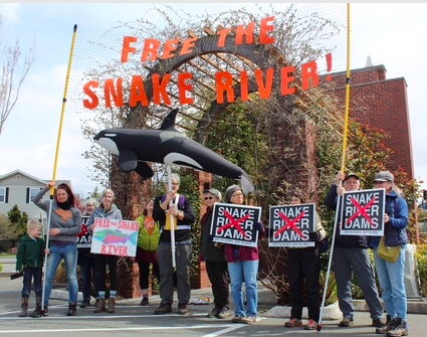forum
library
tutorial
contact

Edmonds-Woodway Graduate Helps
Advocate for the Removal of Dams
by Staff
Edmonds Beacon, April 21, 2022
|
the film forum library tutorial contact |

|
Edmonds-Woodway Graduate Helps
by Staff
|
Group marches in Edmonds to protect endangered salmon and orcas
 Last Saturday, Alison Penny joined a conservation group in a march down SR 104 at Dayton Street West to the foot of Main Street. Their cause? Advocating for the breaching of the four lower hydroelectric Snake River dams in Washington state to help protect endangered salmon and orca populations.
Last Saturday, Alison Penny joined a conservation group in a march down SR 104 at Dayton Street West to the foot of Main Street. Their cause? Advocating for the breaching of the four lower hydroelectric Snake River dams in Washington state to help protect endangered salmon and orca populations.
Penny, an Edmonds-Woodway graduate -- class of 2014 -- held one end of a "Free the Snake River" banner as the group made its way to Main Street, later holding up a large, inflatable chinook salmon as she waved to drivers and pedestrians leaving and entering the ferry.
Penny also joined the group last month when members raised a banner on SR 104 near Highway 99.
Penny's just 26, but she's been a lifelong supporter of restoring salmon runs in Puget Sound.
Her father worked with the nonprofit American Rivers, whose stated goal is to protect and restore wild rivers. It has called for the removal of the lower Snake River dams -- Ice Harbor, Lower Monumental, Little Goose, and Lower Granite, built in the 1960s and early 1970s.
"I grew up with a love for rivers, salmon, and our natural ecosystem," she said. "When I got older, I started working in Alaska at a salmon processing plant and for the fishing industry. It was fun, but a lot of hard work."
Penny and others said they were helping to raise the alarm on the worsening salmon extinction crisis.
The organizer of the Edmonds event, Amy Morrison, is deputy director of the Vashon-based Backbone Campaign.
She said U.S. Sen. Patty Murray and Gov. Jay Inslee have launched a process to develop a comprehensive plan to protect and restore Snake River salmon.
"Right now, they are developing a report to identify our region's options for replacing the lower Snake River dams' energy, and shipping and irrigation services," Morrison said.
They have promised to deliver their plan -- including a decision on the future of these four dams -- by July 31.
"Northwest tribes, sport and commercial fishing groups, people of faith, outdoor recreational enthusiasts' associations, and national, regional, and local conservation organizations support a comprehensive plan to remove those dams and replace the services they now provide with investments in clean energy resources, grid modernization, and agricultural irrigation and transportation," Morrison said.
"Without bold, urgent action, scientists predict that many Snake River salmon populations will begin to disappear within the next five to 10 years."
Penny said a major concern is the biodiversity of the Snake River.
"Salmon plays a huge part in that, and it affects everything from the mountain tops to downstream here in Puget Sound. Our orca whales and a lot of other species in Puget Sound rely on chinook salmon. They are the largest and fattiest of the Pacific salmon, and nourish orcas in our resident pod here.
"There's a huge salmon run that would be on the Snake and the Columbia if it wasn't for the dams."
A March 2021 report by Brad Hanson and 14 others at the NOAA Fisheries Northwest Fisheries Science Center concluded that while orcas sometimes eat other species -- including halibut, lingcod, and steelhead -- they depend most on Chinook.
"What is at stake is really about preventing salmon and steelhead extinction," said Doug Howell, one of Saturday's participants.
"What's clear is that we can replace (electrical) power with clean energy, and may well be able to do it cost-effectively at the same or current prices. The network of wind, solar, and battery will ultimately be much more resilient than the current, existing four lower Snake River dams."
In 2018, Gov. Inslee created the Southern Resident Orca Task Force task to look for ways to improve the plight of orcas. The task force met for nearly two years and recommended 49 actions.
The final report did not address the Snake River dams. Inslee hired a team of consultants to interview community stakeholders for a report to help inform the state's position on the federal court-ordered Environmental Impact Statement (EIS) on the dams.
The southern resident orca population is composed of the J, K, and L pods, which spend most of the year in the Salish Sea near the San Juan Islands.
In pursuit of migrating salmon, the orcas are also known to head south -- and can be seen from Edmonds -- during the fall and spend time near the Columbia River mouth during the winter months.
learn more on topics covered in the film
see the video
read the script
learn the songs
discussion forum
